2016 Peugeot 308 gearbox
[x] Cancel search: gearboxPage 5 of 398
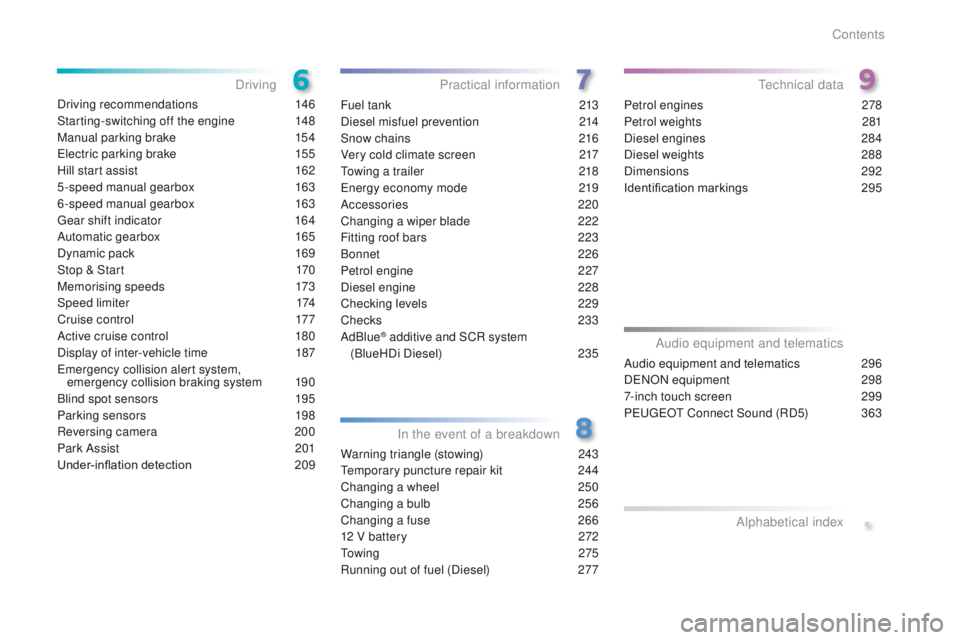
Driving recommendations 146
Starting-switching off the engine
1
48
Manual parking brake
1
54
el
ectric parking brake
1
55
Hill start assist
1
62
5-speed manual gearbox
1
63
6-speed manual gearbox
1
63
ge
ar shift indicator
1
64
Automatic gearbox
1
65
Dynamic pack
1
69
Stop & Start
1
70
Memorising speeds
1
73
Speed limiter
1
74
Cruise control
1
77
Active cruise control
1
80
Display of inter-vehicle time
1
87
em
ergency collision alert system,
emergency collision braking system
1
90
Blind spot sensors
1
95
Parking sensors
1
98
Reversing camera
2
00
Park Assist
2
01
Under-inflation detection
20
9Fuel tank
2 13
Diesel misfuel prevention
2
14
Snow chains
2
16
Very cold climate screen
2
17
to
wing a trailer
2
18
en
ergy economy mode
2
19
Accessories
2
20
Changing a wiper blade
2
22
Fitting roof bars
2
23
Bonnet
226
Petrol engine
2
27
Diesel engine
2
28
Checking levels
2
29
Checks
233
AdBlue
® additive and SCR system
(
BlueHDi Diesel)
23
5
Warning triangle (stowing)
2
43
te
mporary puncture repair kit
2
44
Changing a wheel
2
50
Changing a bulb
2
56
Changing a fuse
2
66
12 V battery
2
72
to
w i n g
2 7 5
Running out of fuel (Diesel)
2
77Petrol engines
2
78
Petrol weights
2
81
Diesel engines
2
84
Diesel weights
2
88
Dimensions
2
92
Identification markings
2
95
Driving
Practical information
In the event of a breakdownte chnical data
.
Audio equipment and telematics 296
D
eN
ON equipment
2
98
7-inch touch screen
2
99
Peuge
O
t Connect Sound (RD5)
3
63
Audio equipment and telematics
Alphabetical index
Contents
Page 9 of 398
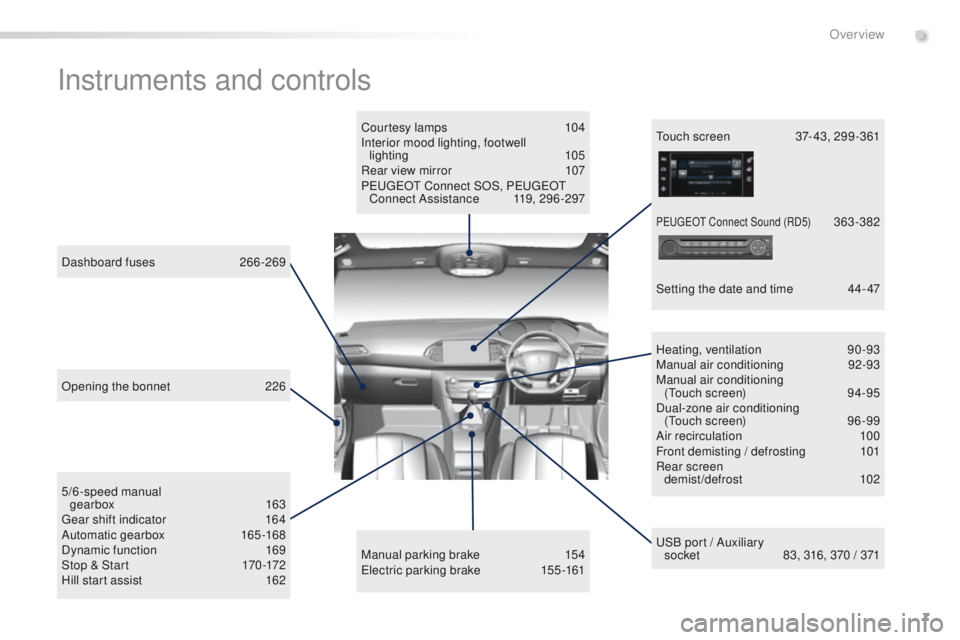
7
Instruments and controls
Courtesy lamps 104
Interior mood lighting, footwell lighting
105
Rear view mirror
1
07
Peuge
O
t Connect SOS, Peuge
O
t
Connect Assistance
1
19, 296 -297
uS
B port / Auxiliary
socket
8
3, 316, 370 / 371
5/6-speed manual
gearbox
163
ge
ar shift indicator
1
64
Automatic gearbox
16
5 -168
Dynamic function
1
69
Stop & Start
1
70 -172
Hill start assist
1
62
Dashboard fuses
2
66-269 Heating, ventilation
9
0-93
Manual air conditioning
9
2-93
Manual air conditioning (
to
uch screen)
9
4-95
Dual-zone air conditioning (
to
uch screen)
9
6 -99
Air recirculation
1
00
Front demisting / defrosting
1
01
Rear screen demist/defrost
1
02
Manual parking brake
1
54
el
ectric parking brake
1
55 -161to uch screen 3 7- 43, 299 -361
Setting the date and time
4
4- 47
Opening the bonnet
2
26
PeugeO t Connect Sound (RD5) 363-382
.
Over view
Page 12 of 398
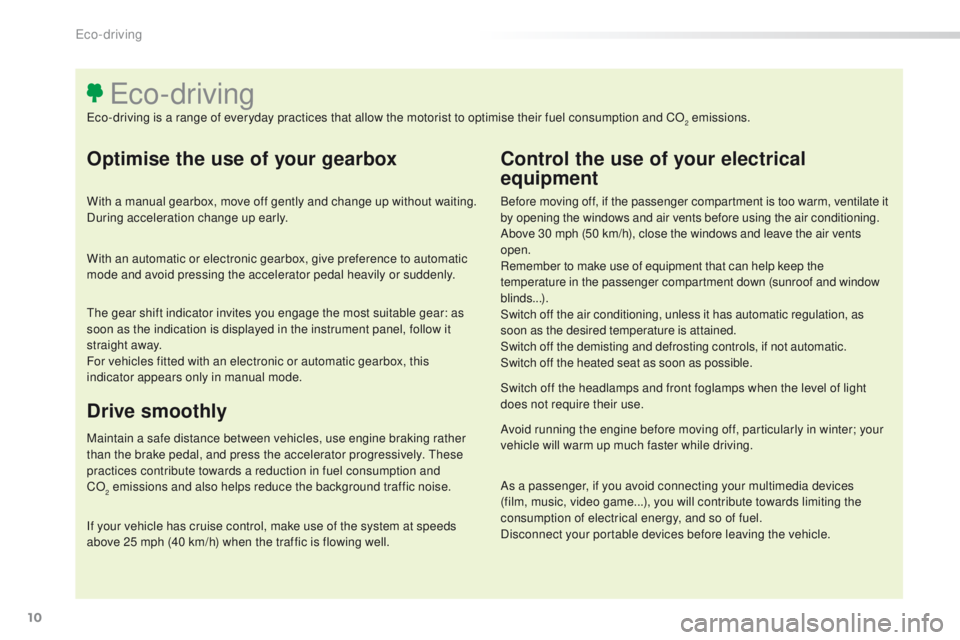
10
Optimise the use of your gearbox
With a manual gearbox, move off gently and change up without waiting.
During acceleration change up early.
With an automatic or electronic gearbox, give preference to automatic
mode and avoid pressing the accelerator pedal heavily or suddenly.
Control the use of your electrical
equipment
Before moving off, if the passenger compartment is too warm, ventilate it
by opening the windows and air vents before using the air conditioning.
Above 30 mph (50 km/h), close the windows and leave the air vents
open.
Remember to make use of equipment that can help keep the
temperature in the passenger compartment down (sunroof and window
blinds...).
Switch off the air conditioning, unless it has automatic regulation, as
soon as the desired temperature is attained.
Switch off the demisting and defrosting controls, if not automatic.
Switch off the heated seat as soon as possible.
Switch off the headlamps and front foglamps when the level of light
does not require their use.
Avoid running the engine before moving off, particularly in winter; your
vehicle will warm up much faster while driving.
As a passenger, if you avoid connecting your multimedia devices
(film, music, video game...), you will contribute towards limiting the
consumption of electrical energy, and so of fuel.
Disconnect your portable devices before leaving the vehicle.
eco-driving
eco-driving is a range of everyday practices that allow the motorist to optimise their fuel consumption and CO2 emissions.
Drive smoothly
Maintain a safe distance between vehicles, use engine braking rather
than the brake pedal, and press the accelerator progressively. th ese
practices contribute towards a reduction in fuel consumption and
CO
2 emissions and also helps reduce the background traffic noise.
I
f your vehicle has cruise control, make use of the system at speeds
above 25 mph (40 km/h) when the traffic is flowing well.
th
e gear shift indicator invites you engage the most suitable gear: as
soon as the indication is displayed in the instrument panel, follow it
straight away.
For vehicles fitted with an electronic or automatic gearbox, this
indicator appears only in manual mode.
Eco-driving
Page 14 of 398

12
Instrument panel
1. Fuel gauge.
2. Analogue speedometer (mph or km/h).
3.
e
n
gine oil level indicator.
4.
g
e
ar shift indicator.
g
e
ar with an automatic gearbox.
5.
D
igital speedometer (mph or km/h).
6.
C
ruise control or speed limiter settings. A. M
ain lighting dimmer.
B. R eset the trip distance recorder.
I
nstantaneous information on:
-
servicing,
-
r
emaining driving range with the
emissions additive.
7. S
ervice indicator, then total distance
recorder (miles or km).
t
h
ese functions are displayed in turn when
the ignition is switched on.
8.
t
r
ip distance recorder (miles or km).
9.
R
ev counter (x 1 000 rpm or tr/min),
graduation according to engine (petrol or
Diesel).
10.
e
ng
ine coolant temperature gauge.
Dials and screens Control buttons
Instruments
Page 17 of 398
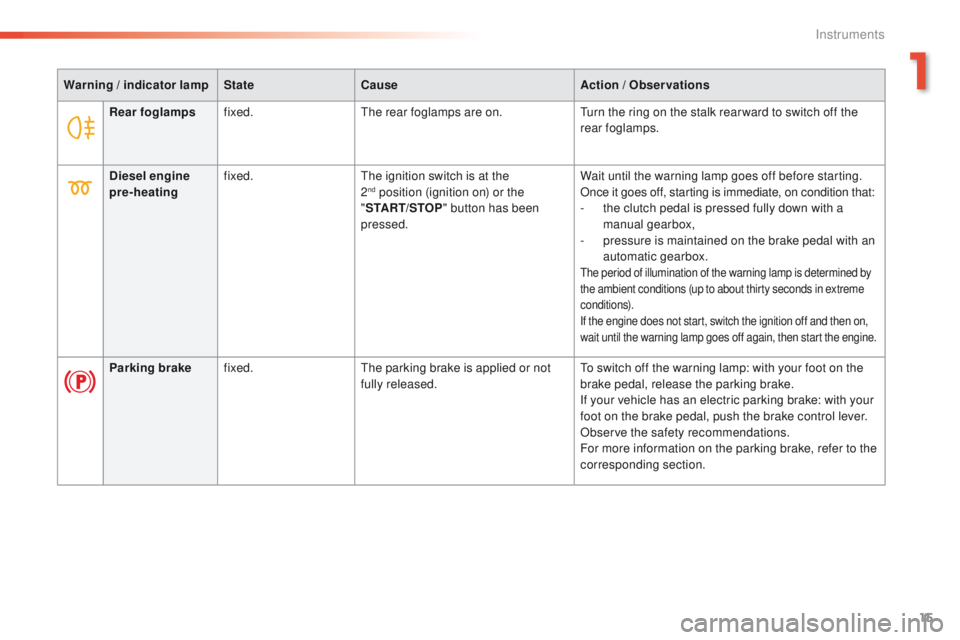
15
Warning / indicator lamp State Cause Action / Observations
Rear foglamps fixed.
th
e rear foglamps are on.
tu
rn the ring on the stalk rear ward to switch off the
rear foglamps.
Diesel engine
pre-heating fixed.
th
e ignition switch is at the
2
nd position (ignition on) or the
" ST
ART/STOP " button has been
pressed. Wait until the warning lamp goes off before starting.
Once it goes off, starting is immediate, on condition that:
-
t he clutch pedal is pressed fully down with a
manual gearbox,
-
p
ressure is maintained on the brake pedal with an
automatic gearbox.
the period of illumination of the warning lamp is determined by
the ambient conditions (up to about thirty seconds in extreme
conditions).
If the engine does not start, switch the ignition off and then on,
wait until the warning lamp goes off again, then start the engine.
Parking brake fixed.th e parking brake is applied or not
fully released.to s witch off the warning lamp: with your foot on the
brake pedal, release the parking brake.
If your vehicle has an electric parking brake: with your
foot on the brake pedal, push the brake control lever.
Observe the safety recommendations.
For more information on the parking brake, refer to the
corresponding section.
1
Instruments
Page 22 of 398
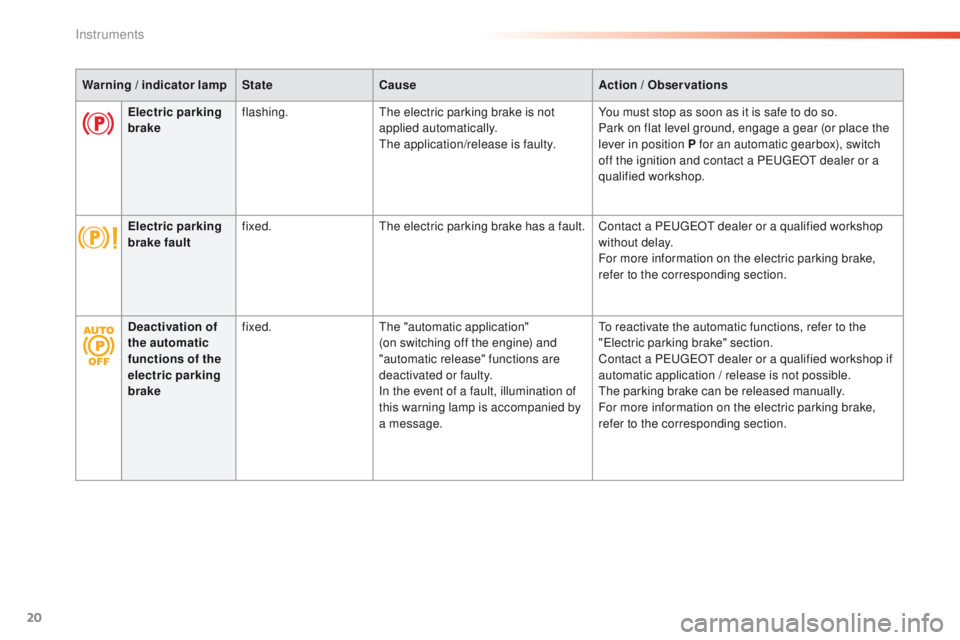
20
Warning / indicator lamp State Cause Action / Observations
Electric parking
brake flashing.
th
e electric parking brake is not
applied automatically.
th
e application/release is faulty.You must stop as soon as it is safe to do so.
Park on flat level ground, engage a gear (or place the
lever in position P for an automatic gearbox), switch
off the ignition and contact a P
e
uge
Ot
dealer or a
qualified workshop.
Electric parking
brake fault fixed.
th
e electric parking brake has a fault. Contact a P
e
uge
Ot
dealer or a qualified workshop
without delay.
For more information on the electric parking brake,
refer to the corresponding section.
Deactivation of
the automatic
functions of the
electric parking
brake fixed.
th
e "automatic application"
(on switching off the engine) and
"automatic release" functions are
deactivated or faulty.
In the event of a fault, illumination of
this warning lamp is accompanied by
a message.
to r
eactivate the automatic functions, refer to the
"
el
ectric parking brake" section.
Contact a P
e
uge
Ot
dealer or a qualified workshop if
automatic application
/ release is not possible.
th
e parking brake can be released manually.
For more information on the electric parking brake,
refer to the corresponding section.
Instruments
Page 26 of 398

24
Engine oil
pressurefixed.th
ere is a fault with the engine
lubrication system. You must stop as soon it is safe to do so.
Park, switch off the ignition and contact a Pe
ugeOt
dealer or a qualified workshop.
Deflated tyre fixed.
th
e pressure in one or more tyres is
too low. Check the pressures of the tyres as soon as possible.
th
is check should preferably carried out with the tyres
cold.
flashing then fixed.
th
e under-inflation detection system
has a fault. Have it checked by a P
e
uge
Ot
dealer or a qualified
workshop.
For more information on under-inflation detection,
refer to the corresponding section.
Warning
/ indicator lamp
State Cause Action
/ Observations
Foot on the
brake pedal fixed.
th
e brake pedal must be pressed. With an automatic gearbox, press the brake pedal, engine running, before releasing the parking brake, to
unlock the lever and come out of position P .
If you wish to release the parking brake without
pressing the brake pedal, this warning lamp will
remain on.
Foot on the
clutch fixed.
In the S
tO
P mode of Stop & Start,
changing to S
tA
R
t
mode is refused
because the clutch pedal is not fully
down. You must declutch fully to allow the change to engine
S
t
A R
t m
o d e .
Instruments
Page 148 of 398
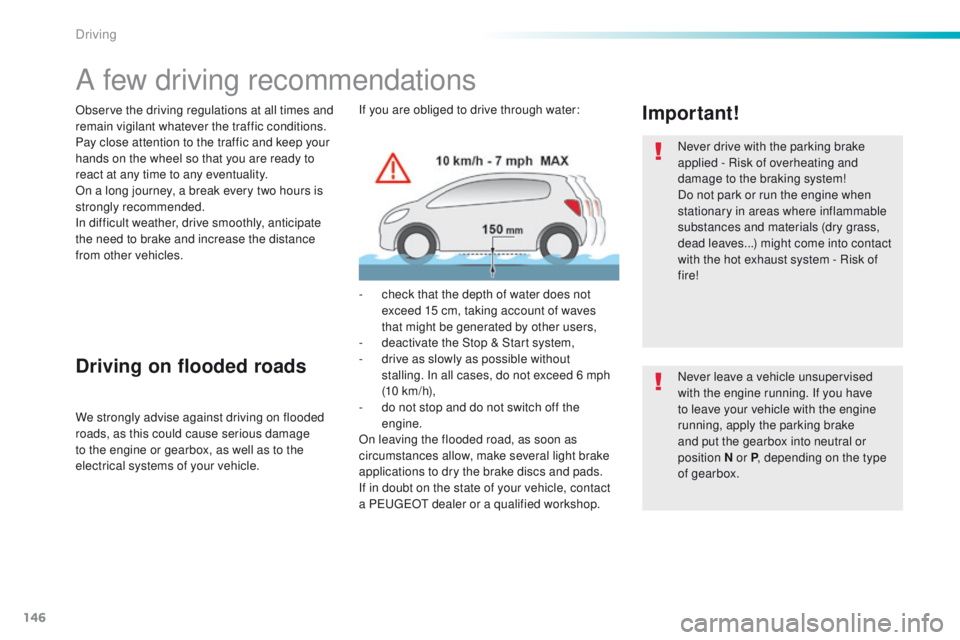
146
A few driving recommendations
Observe the driving regulations at all times and
remain vigilant whatever the traffic conditions.
Pay close attention to the traffic and keep your
hands on the wheel so that you are ready to
react at any time to any eventuality.
On a long journey, a break every two hours is
strongly recommended.
In difficult weather, drive smoothly, anticipate
the need to brake and increase the distance
from other vehicles.Never drive with the parking brake
applied - Risk of overheating and
damage to the braking system!
Do not park or run the engine when
stationary in areas where inflammable
substances and materials (dry grass,
dead leaves...) might come into contact
with the hot exhaust system - Risk of
fire!
Never leave a vehicle unsupervised
with the engine running. If you have
to leave your vehicle with the engine
running, apply the parking brake
and put the gearbox into neutral or
position
N or P, depending on the type
of gearbox.
Driving on flooded roads
We strongly advise against driving on flooded
roads, as this could cause serious damage
to the engine or gearbox, as well as to the
electrical systems of your vehicle.
Important!If you are obliged to drive through water:
-
c
heck that the depth of water does not
exceed 15 cm, taking account of waves
that might be generated by other users,
-
d
eactivate the Stop & Start system,
-
d
rive as slowly as possible without
stalling. In all cases, do not exceed 6 mph
(10
km/h),
-
d
o not stop and do not switch off the
engine.
On leaving the flooded road, as soon as
circumstances allow, make several light brake
applications to dry the brake discs and pads.
If in doubt on the state of your vehicle, contact
a P
e
uge
Ot
dealer or a qualified workshop.
Driving